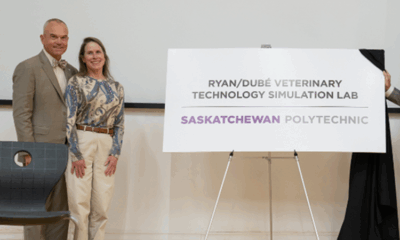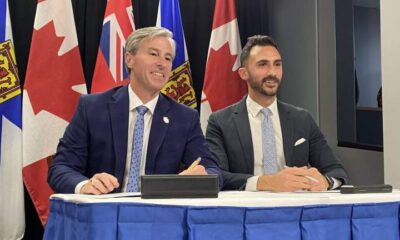Business
Geiger Energy Launches Winter Drill Program at Hook Project

Geiger Energy Corp has announced plans for a winter drill program at its Hook Project in the Athabasca Basin of northern Saskatchewan, set to commence in early 2026. This initiative will focus on testing two significant alteration systems identified during previous drilling in 2024. The program aims to explore the potential for additional uranium mineralization, building on the promising results from the ACKIO discovery.
The winter campaign will specifically target two areas within the Hook Project: the TT area, located approximately 5.5 kilometers southwest of ACKIO, and the TAB area, situated about 6 kilometers northeast. Both regions exhibit extensive hydrothermal clay alteration, a critical indicator of uranium-bearing systems. Preliminary findings indicated elevated radioactivity and uranium values, highlighting the area’s potential for further discovery.
Exploration Details and Potential
The TT area has shown drill intersections with clay alteration ranging from 30 to 145 meters across five drill holes, including HK24-016 and HK24-022. These findings reveal strong clay alteration features and radioactivity levels reaching up to 300 counts per second (cps), with uranium concentrations as high as 98.4 parts per million (ppm). Additionally, elevated boron levels were detected, further indicating the area’s mineral potential.
In the TAB area, significant fracturing and hydrothermal alteration have been identified between 130 and 230 meters in thickness in two drill holes, HK24-009 and HK24-010. Radioactivity levels in this area reached up to 890 cps, with uranium values ranging from 61.6 to 119.3 ppm. The presence of elevated boron in altered intervals suggests promising conditions for uranium mineralization.
According to Rebecca Hunter, President and Chief Executive Officer of Geiger Energy, “The clay alteration and elevated radioactivity at Hook are highly encouraging and warrant immediate follow-up. With proven fertility through the ACKIO discovery, the project clearly has potential for additional uranium mineralization.” This sentiment underscores Geiger’s commitment to exploring and advancing its projects year-round.
Continuous Exploration Efforts
The winter drill program at Hook is part of Geiger’s broader strategy to maintain exploration momentum across its two primary uranium districts. The company is also progressing with its summer exploration at the Aberdeen Project in the Thelon Basin, ensuring a steady flow of results and updates for investors and stakeholders. Preliminary updates regarding the Aberdeen Project’s summer drilling results are expected to be released shortly.
Geiger Energy holds approximately 390,000 hectares of exploration land in the Athabasca Basin and an additional 95,519 hectares in Nunavut’s Thelon Basin. The company targets high-grade uranium deposits within these prolific districts, with the Aberdeen Project hosting notable discoveries such as the Tatiggaq and Qavvik uranium finds. The Tatiggaq prospect alone has demonstrated significant potential, with drill intercepts revealing grades of up to 2.25% U3O8 over 11.1 meters.
The upcoming winter drill program at the Hook Project is poised to be a critical step in uncovering further uranium mineralization, reinforcing Geiger Energy’s position in the competitive uranium exploration landscape. The company plans to share more detailed results and plans following the review of data from the 2024 exploration efforts in the coming months.
As Geiger Energy continues its exploration activities, the potential for new discoveries in both the Hook and Aberdeen Projects remains a focal point for stakeholders, underscoring the significance of the Athabasca Basin and Thelon Basin as leading uranium jurisdictions.
-

 World4 months ago
World4 months agoScientists Unearth Ancient Antarctic Ice to Unlock Climate Secrets
-

 Entertainment4 months ago
Entertainment4 months agoTrump and McCormick to Announce $70 Billion Energy Investments
-

 Lifestyle4 months ago
Lifestyle4 months agoTransLink Launches Food Truck Program to Boost Revenue in Vancouver
-

 Science4 months ago
Science4 months agoFour Astronauts Return to Earth After International Space Station Mission
-

 Technology2 months ago
Technology2 months agoApple Notes Enhances Functionality with Markdown Support in macOS 26
-

 Top Stories3 weeks ago
Top Stories3 weeks agoUrgent Update: Fatal Crash on Highway 99 Claims Life of Pitt Meadows Man
-

 Sports4 months ago
Sports4 months agoSearch Underway for Missing Hunter Amid Hokkaido Bear Emergency
-

 Politics3 months ago
Politics3 months agoUkrainian Tennis Star Elina Svitolina Faces Death Threats Online
-

 Politics4 months ago
Politics4 months agoCarney Engages First Nations Leaders at Development Law Summit
-

 Technology4 months ago
Technology4 months agoFrosthaven Launches Early Access on July 31, 2025
-

 Top Stories2 weeks ago
Top Stories2 weeks agoFamily Remembers Beverley Rowbotham 25 Years After Murder
-

 Top Stories4 days ago
Top Stories4 days agoBlake Snell’s Frustration Ignites Toronto Blue Jays Fan Fury





















